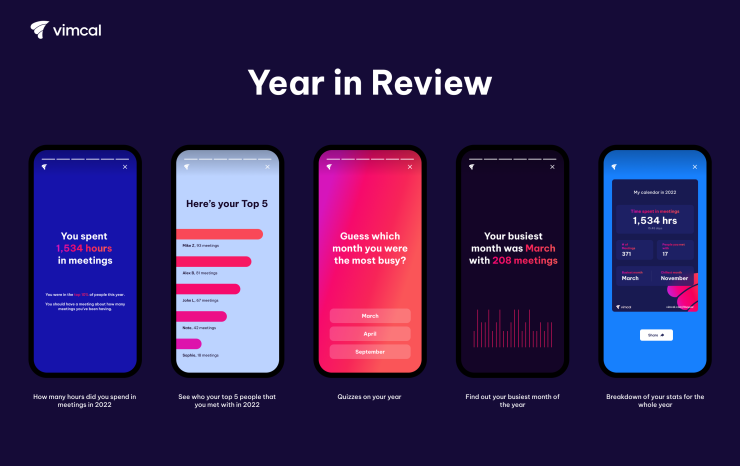In the virtual work world, spending hours in Zoom meetings has become a given. But if you think you've found a good balance between personal work time and group meetings, this new app feature is ready to prove you wrong.
Remote work calendar plug-in Vimcal recently launched a 'Vimcal Rewind' feature for all of their mobile app users. The feature analyzes users'
For most users, this year has been filled with meetings — and lots of them. Vimcal's data found that the average users spent 13.1 hours per week in meetings. They had 539 meetings per year and spent 496 hours in meetings per year.
Read more:
"Everyone wants to see the metrics of how they spend their time, especially when it comes to meetings," says John Li, founder of Vimcal. "Most of our users are founders, investors or CEO types who have a lot of meetings. Some of them have executive assistants that will give them a breakdown of how they're spending their time, and those who don't are using Vimcal."

Vimcal Rewind culls through data entries from the year to calculate findings such as the total
The shift to remote and hybrid work increased the number of meetings in a worker's day by over 25%, according to a survey from Reclaim.ai, a productivity and time blocking app. Li and his team wanted to simultaneously address that shift and urge their users to reconsider how their time is spent. Rewind also includes a percentile ranking to let users know how their time compares to others'.
"We don't want to just be a Spotify Wrapped knockoff — we want to be useful," Li says. "If users do find themselves [in the top percentile], we kind of want to shake them and say 'Hey, take a look. Something needs to change in 2023.'"
Read more:
Most workers still aren't sure how they feel about the rise in
Lee hopes the findings will stimulate conversations around which meetings are most necessary and where that time can be better spent. Giving leaders that information can help set the tone for the rest of the organization.
"Meetings are mostly for deciding what to do or for reviewing what's been done," Li says. "And so if you are a CEO or a founder and you're constantly in meetings, that also means you're making other people have a lot of meetings and those people spend a lot of time not doing their work, but preparing for those meetings with you. It all starts from the top down."






